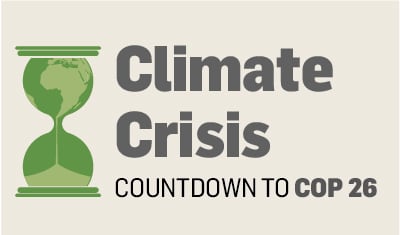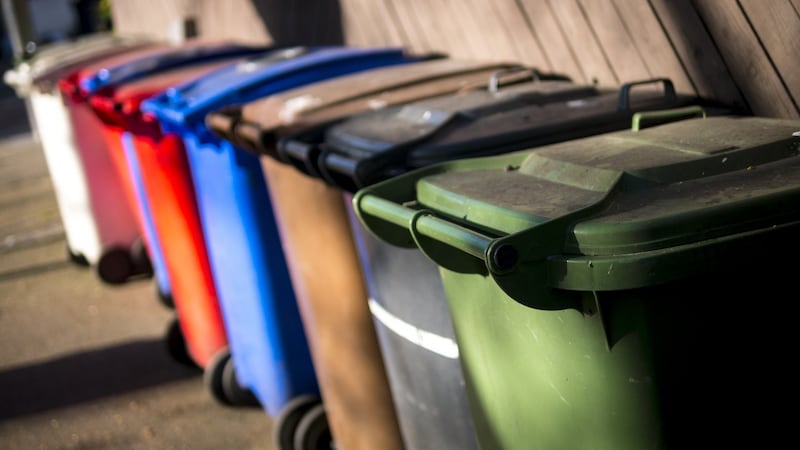“Why does it matter what I put in my rubbish bins; sure doesn’t it all end up in landfill?” This might have been a perfectly valid viewpoint 20 years ago, but in the past 10-15 years the journey of the contents of our domestic bins has become more varied and arguably more transparent, despite the few rogue operators still illegally dumping domestic waste on roadsides and in unlicensed landfill sites.
The transformation of what happens to the wide variety of items we, as householders, put into our mixed waste bin, recyclable waste and compostable waste is – in many ways – a good news story. However, it took China’s refusal to accept the colossal amount of contaminated mixed waste materials from European countries, the United States and Australia in 2017 to force waste management companies to change their ways. The reduction of Irish landfill sites from about 125 in 2000 to three in 2021 as part of the European Union’s Landfill Directive is another part of the story.

“I can’t say with 100 per cent certainty where everything goes, but when the Chinese sword came down in 2017 it was a wake-up call to the world,” explains Séamus Clancy, chief executive of Repak, the not-for profit industry body which was set up in 1997 to ensure large retailers and manufacturers meet their EU obligations to recycle the packaging they put on the market.
“What happened to our waste was previously out of sight, out of mind, but then we realised we had to step up to the plate and do it [find destinations for our rubbish] on our own doorstep,” says Clancy.
Images of mountains of waste polluting air and water in Asian countries shocked consumers in the western world who up to then hadn’t worried about where their rubbish went when they threw it away. Once people realised there is no “away”, environmental non-governmental organisations began asking questions about the destinations of exported waste materials from Ireland. This growing awareness forced closer monitoring of the transportation of waste overseas and coincided with higher EU recycling targets for plastics, glass, food and drink cans, food waste and other materials.
The best way to ensure your household waste doesn't end up in an unlicensed landfill or on the side of the road is to sign up with a licensed waste collector
“We prefer to have full traceability on end destinations rather than [stuff] ending up in landfill in a distant country where there is no accountability,” says Clancy. The fees paid by retailers and manufacturers signed up to Repak (representing 70 per cent of packaging waste) subsidise household recycling bins, bottle banks, and local authority recycling centres. And Repak, in turn, monitors what goes into the depots of private waste management operators and crucially what goes out and where it goes.
The introduction of the circular economy – where a value is placed on the reuse of these secondary materials – was the final piece of the jigsaw to make it worthwhile for waste management companies to encourage everyone to diligently separate their rubbish while also reducing their bin charges (your mixed waste bin is the most expensive to lift so it makes sense to separate as much food and recyclable waste into your other bins). Some waste collectors provide customers with the weight of each bin lifted but haven’t as yet penalised customers for incorrectly sorting their waste (although some have put cameras on recycling trucks to monitor what’s going in).
The best way to ensure your household waste doesn't end up in an unlicensed landfill or on the side of the road is to sign up with a licensed waste collector, according to Des Crinion, head of recycling at Panda and director of the Irish Waste Management Association which accounts for about 80 per cent of the waste processed in Ireland. You can check whether your local waste collection company has a waste collection permit with the National Waste Collection Permits Office. The Environmental Protection Agency (EPA) issues licences to waste treatment plants and has prosecuted 19 companies since 2016 for lack of compliance.
Crinion says there is no area in Ireland not serviced by the household wheelie bin service. “Any home that wants a wheelie bin service, it’s available to them. Every waste collector should have a waste collection permit. Most of the illegal activity happens with household clean-ups or site clearances rather than with household waste,” says Crinion.
Now, let’s take a whistle stop tour of your domestic bins to find out where the contents go if they are collected by a waste management company compliant with their licence.
Starting with the brown bin – which, if you are disposing of your rubbish correctly, should contain only cooked and raw food, light garden waste and compostable packaging. “The contents of the brown bins go for anerobic digestion or industrial composting and the waste management companies pay for it to be taken,” explains Crinion. There are seven private industrial composting facilities in Ireland licensed by local authorities or the EPA and the Department of Agriculture. The compost made at these sites is sold principally as peat replacement for landscaping, agriculture and horticulture.

The recycling bin is what creates value and the commodity prices today are at an all-time high
The Composting and Anerobic Digestion Association of Ireland (Cré) began certifying compostable packaging in June 2021. Percy Foster, chief executive of Cré, says the organisation would like to see a similar subsidy for brown bins as exists for recycling bins. "In Italy, fees paid by producers placing compostable plastics on the market are now used only for subsidising the collection and recycling of food waste and compostable plastics. We'd like to see a similar scheme introduced here independent of Repak," says Foster.
About 800,000 householders throughout Ireland have a compostable waste bin (usually a brown bin) from a total of 1.3 million householders availing of kerbside waste collection services.
The contents of about 10 per cent of brown bins are sent to anerobic digestors in Ireland and the UK where methane gas is extracted and turned into electricity fed into the grid. The residual material – known as digestate – is used by farmers to spread on their land as an organic alternative to nitrogen fertilisers thus reducing the amount of greenhouse gases emitted into the atmosphere by this source.
The contents of the recycling bin are processed in recycling plants otherwise known as material recovery facilities. Here the contents are unloaded from trucks on a conveyor belt system which uses different tools to separate metals from plastics and paper. Materials which don’t fit into these categories are, according to Crinion, made into what’s called solid recovered fuel to be used in cement kilns instead of coal.
“The recycling bin is what creates value and the commodity prices today are at an all-time high. For example, recycled plastic is now worth more than virgin plastic which is a positive effect of legislation requiring manufacturers to use recycled plastic in their packaging,” says Crinion.
The aluminium is the highest value material in the recycling bin and it is sold to smelters in the US and Europe
Soft plastics were reintroduced into recycling bins in September 2021, having been removed in 2017 due to high levels of contamination and inadequate recycling capabilities. “Since 2017, the waste industry has improved its facilities to accept soft plastics and there has been a big reduction in contamination [eg food left on plastics] although there are still some issues,” explains Clancy.
Crinion explains that the majority of the paper from recycling bins is sold within Europe although a little goes to India. “Sixty per cent of paper went to Asia before 2017. Now, that’s down to about 10 per cent. The aluminium is the highest value material in the recycling bin and it is sold to smelters in the US and Europe. Steel cans go to Spain and Turkey and currently PET bottles go to the UK, Spain, Italy and Germany.”
All plastics now stay in Europe for processing, according to Crinion, and some are also processed in Ireland. For example, entrepreneur Billy Costello, who owns the Green Generation anerobic digestor facility in Co Kildare, is planning to build a plant to reprocess plastic into road barriers, railway sleepers and electricity poles. And Panda is building a plant which will process recycled PET bottles into pellets to be used to create more bottles in Portlaoise, Co Laois. “This will be the first plant in Ireland to create bottles from bottles. We will be able to cope with 100 per cent of the plastic bottles on the Irish market,” says Crinion. (Crinion also argues that Government plans to put reverse-vending machines in shops and other locations is an expensive and outdated approach. Instead, he suggests consumers could digitally scan a code on each plastic bottle before putting it in recycling bins and get paid for each return that way.)
And finally, let’s look inside the mixed waste bin (often a black bin) – which historically contained the majority of our rubbish that ended up in landfill and still amounts to almost half of all waste collected from householders, according to the EPA. “When the black bins come into our depots, we shred it which opens the bags and loosens up materials. About 25 per cent of what’s in black bins is food waste which of course shouldn’t be there. This [lower grade] food waste is sent to anaerobic digestors and used to cover over the waste materials still going into landfill sites,” explains Crinion.
The metals in the mixed waste bins are extracted with magnets and sold to metal refineries in Spain and Turkey. Food cans and aluminium cans are also removed and sold to smelting plants. And small bits of plastics [which should of course be in the recycling bin] are removed and sent to cement kilns as an alternative fuel (known as solid recovered fuel) to coal. The waste management companies pay the cement factories to accept this waste material even though it replaces an imported fossil fuel. The remains of what is in the mixed waste bin – about 50 per cent of its original amount – is sent to be incinerated either at one of the two incinerators in Ireland or to incinerators in Norway, Sweden, Denmark, the Netherlands or Lithuania.
According to Clancy, Repak has strict compliance requirements for material recovery facilities. These include waste characterisation studies on each licensed operator as well as monitoring the documentation received by the companies when they export materials abroad. Trans-frontier shipment regulations require each waste management company that ships waste abroad to identify the exact route and end destination of the materials.
“These things allow us to narrow the risk of materials ending up in the wrong place to the minimum,” argues Clancy.
And, of course, a lot also depends on where, we, as householders, put our waste. “Don’t get me started on littering,” says Crinion. “Can everyone just bring it home and put it in the right bin?”






















